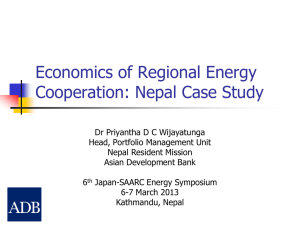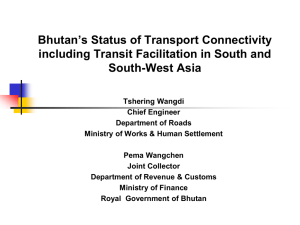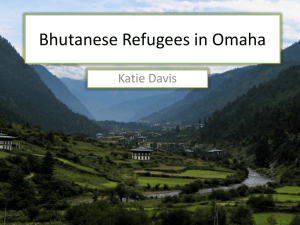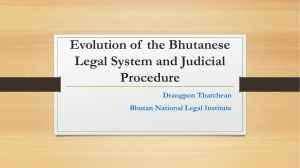Regional Energy Cooperation in Eastern South Asia
advertisement
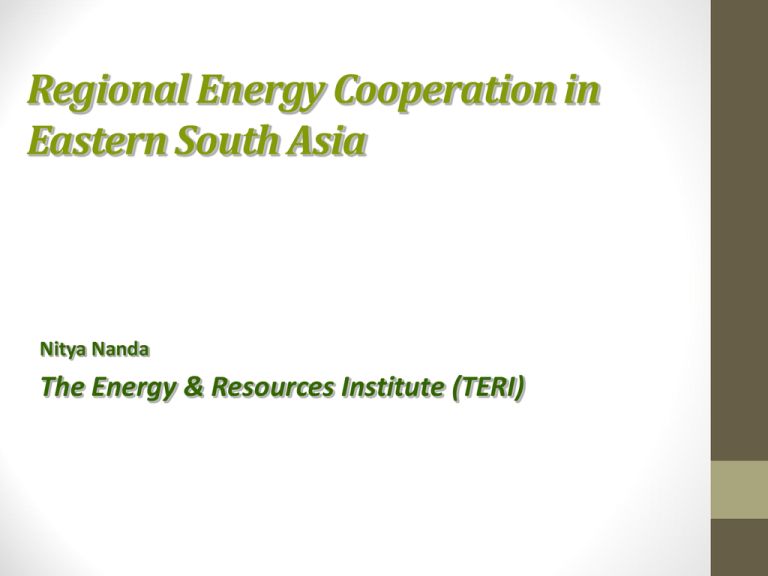
Regional Energy Cooperation in Eastern South Asia Nitya Nanda The Energy & Resources Institute (TERI) Eastern South Asia – A Perspective • It housed one of two most important industrial/growth centres in India (South Asia) • Was an industrially developed sub-region • Most important sub-region in terms of contribution to exports • Due to accident of history, a metropolitan centre lost its hinterland and the hinterland lost its metropolitan centre • Artificial barriers created • Existing transport linkages dismantled (was in operation till 1965) • Existing forward and backward linkages disrupted • Decline of the export-oriented commodity-based industries in general Per Capita Income in Eastern South Asia (US$) South Asian Countries Maldives 7700 Pakistan 1201 Sri Lanka 2816 India 1516 Bangladesh 822 Bhutan 2509 Nepal 656 Myanmar 1126 Indian States Arunachal 1272 Assam 689 Bihar 464 Jharkhand 711 Manipur 595 Meghalaya 986 Mizoram 995 Nagaland 976 Sikkim 2338 Tripura 902 West Bengal 1030 Integration of Bangladesh with … Indian states, Nepal, Bhutan, Myanmar • It is likely that Bangladesh-India low volume of exports is more reflected in terms of Bangladesh and Eastern and North-eastern states of India these states have limited purchasing power • Prosperity of Bangladesh, Myanmar, Nepal, Bhutan and the Indian east and north-eastern states are inter-linked • Eastern South Asia is among the most fragmented subregion and also among the poorest sub-region – a creation of history! • Integration of these countries/states will bring prosperity to all countries/states • Energy sector is an important area for cooperation and can become the driver à la EU The Eastern South Asian Context • Among the lowest per capita incomes in the world • per capita energy consumption is also among the lowest in the world • poorly endowed with conventional energy sources • Huge energy gap and energy poverty • Energy demand likely to grow by three times in the next two decades • Given this context, energy governance both at national and regional levels is extremely important • “Sustainable energy for all” has been identified as one of the SDGs 6 Key Energy Indicators in Eastern South Asia Country/Region South Asia OECD World Africa Bangladesh Bhutan India Nepal TPES/Pop TPES/GDP (toe/capita) (toe/thous 2000USD) TPES/GDP (PPP) (toe/thous 2000USD) Elect Cons 0.55 4.28 1.88 0.67 0.21 0.87 (0.62) 0.60 0.34 0.17 0.14 0.19 0.25 0.13 0.08 0.19 0.23 580 8226 2933 592 263 1619 673 178 0.55 0.14 0.25 0.55 0.36 0.30 0.57 1.34 (KWh/capita) Energy Resources in Eastern South Asia Resources/Country Bangladesh Bhutan India Nepal Coal (Million MT) Lignite (Million MT) Petroleum (Million MT) Natural Gas (Billion Cubic Metre) Hydropower Potential (GW/year) Hydro Generation (GW/Year) Solar (GW Capacity) Wind (GW Capacity) 293 --3 344 --------- 56100 4500 740 1074 --1 --0 4000 263000 2638000 733000 1300 7134 114827 2759 ----- ----- 657 49 --3 Existing Energy Trade in the Region India-Bhutan-NepalBangladesh (Power) Bhutan is the only country in the region with surplus power generation and exports large part of it to India. Nepal imports power from India in a limited quantity. Bangladesh has also started importing from India recently India-Nepal, Bhutan, While Nepal and Bhutan are entirely Bangladesh, (petroleum dependent on India for petroleum products, Bangladesh also imports from products) India India- Bangladesh (Coal) Bangladesh imports from India Natural Gas Bangladesh consumes it but only from domestic production (No export or import), India produces and imports as well. Nepal and Bhutan do not consume Any Trade in Natural Gas? • Except India nobody engages in NG trade as there is no infrastructure • Major international gas pipeline plans: IPI, TAPI, MBI – India was most keen on MBI but could not make any progress due to bilateral differences • Will a regional approach help? What about Nepal and Bhutan’s needs for natural gas? • Bangladesh has internal network of pipelines but it is not connected to any other country • Eastern part of India including the north-eastern states and Nepal and Bhutan are not linked India and Bangladesh: Gas Pipelines Bilateral : Bhutan-India • India-Bhutan: A success story – Significant impact on Bhutan’s GDP, Export, Revenue and Human Development – • Chukha Hydropower Plant started in 1978 and fully commissioned in 1988 • Hydropower projects in Bhutan were built mainly with Indian financial assistance with a significant grant component and technical assistance as well • Bhutan has plans to increase up to 10000MW with Indian guarantee of purchase of half of it • Can it be replicated? Will India fund projects in other countries with similar terms? If yes, how much • So far Bhutan story is more about political and diplomatic success (not market based) Hydro Projects to be completed by 2020 India-Bhutan Interconnection Bilateral : India-Nepal • India-Nepal: Existing linkage is minimal. Several projects are in pipelines. Not much progress • Long history of cooperation (?) – some unfulfilled expectations – once Nepal was keen but India was not, then India changed its position but situation changed in Nepal • Political differences/opposition from CSOs • Private companies (Sutlej/GMR) are interested but govt. is slow • Stiff opposition in Nepal due to potential environmental and social implications • Cost of non-cooperation in Nepal • Severe power shortage – lowest energy access in South Asia • Import of electricity, diesel, kerosene and BoP issues/indebtedness • Excessive use of diesel and kerosene and the related environmental/social implications • Excessive use of woods – social and environmental implications including massive deforestation, soil erosion and land degradation • Does Bhutan care less about the social and environmental issues? • Bhutan is carbon neutral country • Protection forests • Significant improvement in health and education indicators India-Nepal Interconnection Bilateral :Bangladesh-India • India-Bangladesh: 250MW of electricity is flowing through Berhampore-Bheramara transmission line • Price agreed is not market based, but more electricity would be accessed by Bangladesh from Indian market • Bagerhat JV on coal-based power generation • India has agreed in principle for power transmission from Nepal and Bhutan through Indian territory – Nepal has no electricity to offer • Bhutan can offer from additional capacity created – transmission link needed • Indian north-east to Bangladesh power flow potentially possible Bangladesh-India Interconnection Myanmar-Bangladesh-India Gas Corridor – A missed opportunity! • Natural gas is the main export item of Myanmar and it was keen to sell it to India • India was not able to seize the opportunity • India proposed MBI pipelines but Bangladesh agreed (2005) but demanded three things in return • Duty free access • Better transit facilities to Nepal and Bhutan • Access to power from Nepal and Bhutan • India did not agree to discuss these issues together though they energy minister was keen – today India has agreed to all!!! But no pipelines in place • Bangladesh also faces severe shortage of gas (Recognised by 2007) • Bangladesh could have asked for a share of gas instead of bargaining hard linking other issues Energy Cooperation in SE Asia (1/2) • 1st Phase of energy cooperation: Mid-1970s to Mid-1980s Focus on oil and power grid cooperation • ASEAN Council for Petroleum (ASCOPE) in 1976 – active collaboration and mutual assistance in the development of petroleum resources • ASEAN Petroleum Security Agreement (APSA) – mutual supply of oil six countries in sudden shortfalls in supplies – ASEAN had a different context • Power grid cooperation started outside what was then ASEAN • Beginning was made in 1966 when Thailand and Laos concluded a power exchange agreement (Similar to Bhutan-India cooperation) • Similar agreements were signed between Thailand-Malaysia and Malaysia-Singapore in 1978 • ASEAN level cooperation started in 1981 Energy Cooperation in SE Asia (2/2) • 2nd Phase of energy cooperation: Mid 1980s onwards – Cooperation became comprehensive to promote four A’s of energy security: • Availability, Accessibility, Affordability, Acceptability • ASEAN Energy Cooperation Agreement (1986) • 1991: Programme of Action for Enhancement of Cooperation in Energy (PAECE) • 1995: Plan of Action on Energy Cooperation (PAEC 1995-1999) • Oil and gas, coal, new and renewable sources, energy efficiency and conservation with coordination bodies for each of the five areas • 1997: ASEAN Vision 2020 • ASEAN-wide Interconnection arrangement for electricity, natural gas and water ASEAN Power Grid ASEAN Natural Gas Pipelines Southern African Power Pool (1995) • Geared at increasing cross-border electricity trade and ensuring secure and reliable supply to its members with the objectives: • To provide a forum for the development of a world class, robust, safe, efficient, reliable and stable interconnected electrical system in the southern African region • Coordinate and enforce common regional standards of quality of supply, measurement and monitoring of systems performance • Facilitate the development of regional expertise through training programmes and research • Increase power accessibility in rural communities (not achieved). • Implement strategies in support of sustainable development priorities (53% coal, 17% gas and 27% hydro and 3% other renewables) • Few countries engage in trade, trading arrangements are bilateral and prices and quantities are negotiated as DAM not deep • Huge experience and capacity gap – SA (80% capacity and 78% consumption) – Just like South Asia! South African Power Pool Map SAPP Statistics 2012-13 Energy Governance at National Level • Market development is incomplete in national level • Energy governance entails balancing between energy security and other socio-economic and environmental concerns – reaching consensus is difficult • In most countries, electricity and other energy products and services are subsidized • In India, there is significant power trading, and to that extent, price is market-based in the wholesale market • In the absence of reference price international trade in electricty becomes difficult - Bangladesh perceived Indian offer price to be too high!! • In future, neighbouring countries can participate in Indian market with competitive terms (no need to negotiate price) Regional Governance- Some Pointers • Some complexity – even Nepal wants electricity from Bhutan, Bangladesh wants from Nepal and Bhutan and opposes Indian project in Tipaimukh • Offer of electricity to Bangladesh can change the equations on transit of gas and goods • India has agreed in principle for transit of electricity • India’s achievements in Renewable energy (solar, wind and biomass) – India can provide technology and finance? • India’s quest for energy cooperation with SEA countries through BIMSTEC and ASEAN-India cooperation framework Regional Cooperation: Ways forward Regional energy cooperation can have two broad purposes: Following are the usual modes of engagement: Guaranteeing security of energy supply Minimizing the environmental impacts of energy production, transport and consumption Trade in Energy Commodities Natural Gas pipelines Renewable Energy Investment Flows in Energy Sector (including energy infrastructure) A number of measures can be taken, including infrastructure development, financial mechanisms, regulatory frameworks, R&D, information sharing and capacity building Experience of ASEAN shows bilateral initiatives can be the building blocks of regional cooperation Thank You

